Bắc Ninh Province
| Bắc Ninh Province Tỉnh Bắc Ninh | |
|---|---|
| Province | |
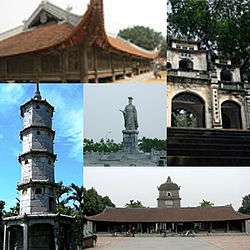 | |
| Nickname(s): The homeland of Quan họ[1] | |
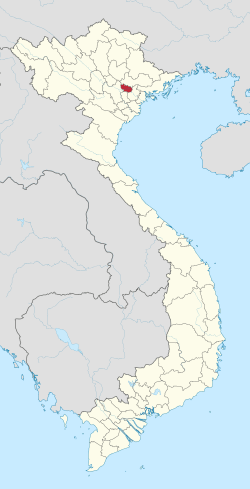 Location of Bắc Ninh within Vietnam | |
| Coordinates: 21°5′N 106°10′E / 21.083°N 106.167°ECoordinates: 21°5′N 106°10′E / 21.083°N 106.167°E | |
| Country |
|
| Region | Red River Delta |
| Capital | Bắc Ninh |
| Government | |
| • Secretary | Nguyễn Nhân Chiến |
| • People's Council Chair | Nguyễn Sỹ |
| • People's Committee Chair | Nguyễn Nhân Chiến |
| Area[2] | |
| • Total | 822.7 km2 (317.6 sq mi) |
| Population (2014) | |
| • Total | 1,131,200[2] |
| • Density | 1,244/km2 (3,220/sq mi) |
| • Density rank | 3 |
| Demographics | |
| • Ethnicities | Vietnamese |
| Time zone | UTC+7 (ICT) |
| Area codes | 222 |
| ISO 3166 code | VN-56 |
| Vehicle registration | 99 |
| Website |
www |
Bắc Ninh (![]()
The province is rich in culture and is known nationally for Quan họ folk music. Quan họ was recognised as the Intangible Cultural Heritage by the UNESCO in 2009.[3]
History
Under the dynasties of the Hùng kings, Bắc Ninh belonged to bộ Vu Ninh (bộ is at a local level the highest administrative unit under the dynasties of the Hùng kings). Under the Lý and Trần dynasties, it belonged to lộ Bắc Ninh; it belonged to thừa tuyên Kinh Bac under the Lê dynasty and then changed into trấn Kinh Bac and Bac Ninh. Under the Minh Mạng dynasty (1831) it was renamed Bac Ninh province.
On 27 October 1962, Bắc Ninh province and the neighbouring Bắc Giang Province were united as Hà Bắc Province. On 6 November 1996 at the 10th Session of the 9th National Congress, Hà Bắc province was separated into two provinces, Bac Ninh and Bac Giang. The administrative system of Bắc Ninh province operates since 1 January 1997.
Geography
Topography
Bắc Ninh has a rather even and flat terrain, mainly sloping from north to south and west to east, causing currents to flow down into Duong River and Thái Bình River. The terrain odds is not much; field areas are 3-7m high and hill and mountain areas are 300-400m high above sea level. Its hills and mountains only make up 0.53 per cent of its natural area mainly in the two districts of Quế Võ and Tiên Du. Besides, there are shallow depressions along dykes under districts of Gia Binh, Luong Tai, Que Vo, and Yen Phong.
Natural resources
The province's total natural land area is 822.7 km2, in which agricultural land, forestry land, specialized and residential land and unused land accounts for 54%, 0.7%, 31% and 14.3% respectively. The province's mineral reserve is limited: mainly construction materials such as clay in Que Vo and Tien Du, sandstone in Thi Cau, Vu Ninh, Bắc Ninh town and peat in Yen Phong.
Climate
Bắc Ninh features a warm humid subtropical climate (Köppen Cwa) with plentiful precipitation. Bắc Ninh is located in a tropical monsoon region. The annual average temperature is 24 °C. The highest is 30 °C in July; the lowest is 15 °C in January. The province experiences the typical climate of northern Vietnam, where summers are hot and humid, and winters are, by national standards, relatively cold and dry. Summers, lasting from May to September, are hot and humid, receiving the majority of the annual 1,680 millimetres (66.1 in) of rainfall. The winters, lasting from November to March, are relatively mild, dry (in the first half) or humid (in the second half), while spring (April) can bring light rains. Autumn (October) is the best time of the year in terms of weather. The average annual sunshine is 1,530-1,776 hours, relative humidity is 79%.[4]
| Climate data for Bắc Ninh | |||||||||||||
|---|---|---|---|---|---|---|---|---|---|---|---|---|---|
| Month | Jan | Feb | Mar | Apr | May | Jun | Jul | Aug | Sep | Oct | Nov | Dec | Year |
| Average high °C (°F) | 19.9 (67.8) |
20.4 (68.7) |
23 (73) |
27.4 (81.3) |
31.8 (89.2) |
33 (91) |
32.8 (91) |
32.2 (90) |
31.2 (88.2) |
29 (84) |
25.6 (78.1) |
22.1 (71.8) |
27.4 (81.2) |
| Daily mean °C (°F) | 16.5 (61.7) |
17.4 (63.3) |
20 (68) |
24 (75) |
27.7 (81.9) |
29.2 (84.6) |
29.2 (84.6) |
28.8 (83.8) |
27.7 (81.9) |
25.2 (77.4) |
21.6 (70.9) |
18.5 (65.3) |
23.8 (74.9) |
| Average low °C (°F) | 13.2 (55.8) |
14.4 (57.9) |
17.1 (62.8) |
20.6 (69.1) |
23.7 (74.7) |
24.6 (76.3) |
25.5 (77.9) |
25.4 (77.7) |
24.2 (75.6) |
21.4 (70.5) |
17.7 (63.9) |
14.9 (58.8) |
20.2 (68.4) |
| Average rainfall mm (inches) | 12 (0.47) |
33 (1.3) |
34 (1.34) |
87 (3.43) |
211 (8.31) |
245 (9.65) |
332 (13.07) |
337 (13.27) |
234 (9.21) |
98 (3.86) |
34 (1.34) |
23 (0.91) |
1,680 (66.16) |
| Source: climate-data.org[5] | |||||||||||||
Administration divisions
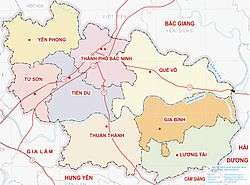
Bắc Ninh is subdivided into 8 district-level sub-divisions:
- 6 districts:
They are further subdivided into 6 commune-level towns (or townlets), 97 communes, and 23 wards.
The Bắc Ninh Province People's Committee is a 9-member executive council for the province. The current chairman is Nguyễn Nhân Chiến. There are several vice chairmen and chairwomen on the committee with responsibility for various province departments. The legislative branch of the province government is called the People's Council and consists of 50 deputies. Both the committee and the council are subordinate to the province's Communist Party, currently led by Party Secretary Trần Văn Túy. The chairman of the People's Committee is the No. 2 position in the city government while chairman of the People's Council is No. 3.
Table of local government districts
| Name | Division type | Population (2009) | Area (km²) | Towns (huyện lỵ or thị trấn) (bold) and communes (xã) |
|---|---|---|---|---|
| Bắc Ninh | City (thành phố) | 164,307 | 82.6 | Wards (phường):Đáp Cầu, Thị Cầu, Vũ Ninh, Suối Hoa, Ninh Xá, Tiền An, Vệ An, Vạn An, Kinh Bắc, Đại Phúc, Võ Cường, Vân Dương, Hạp Lĩnh. Communes (xã): Hòa Long, Phong Khê, Khúc Xuyên, Kim Chân, Nam Sơn, Khắc Niệm |
| Từ Sơn | Township (thị xã) | 140,040 | 61.3 | Wards (phường): Châu Khê, Đình Bảng, Đông Ngàn, (Đồng Nguyên, Đồng Kỵ, Tân Hồng, Trang Hạ. Communes (xã): Hương Mạ, Phù Chẩn, Phù Khê, Tam Sơn, Tương Giang. |
| Thuận Thành District | District (huyện) | 144,536 | 117.9 | Hồ, An Bình, Đại Đồng Thành, Đình Tổ, Gia Đông, Hà Mãn, Hoài Thượng, Mão Điền, Nghĩa Đạo, Ngũ Thái, Nguyệt Đức, Ninh Xá, Song Hồ, Song Liễu, Thanh Khương, Trạm Lộ, Trí Quả, Xuân Lâm. |
| Quế Võ District | District (huyện) | 135,938 | 149.1 | Phố Mới, Bằng An, Bồng Lai, Cách Bi, Chi Lăng, Đức Long, Châu Phong, Đào Viên, Đại Xuân, Hán Quảng, Mộ Đạo, Nhân Hoà, Ngọc Xá, Phượng Mao, Phương Liễu, Phù Lãng, Phù Lương, Quế Tân, Việt Hùng, Việt Thống và Yên Giả. |
| Tiên Du District | District (huyện) | 124,396 | 96.2 | Lim,Cảnh Hưng, Đại Đồng, Hiên Vân, Lạc Vệ, Liên Bão, Minh Đạo, Nội Duệ, Phật Tích, Phú Lâm, Tân Chi, Tri Phương, Việt Đoàn, Hoàn Sơn. |
| Yên Phong District | District (huyện) | 126,660 | 95.2 | Chờ, Dũng Liệt, Đông Phong, Đông Thọ, Đông Tiến, Hòa Tiến, Long Châu, Tam Đa, Tam Giang, Thụy Hòa, Trung Nghĩa, Văn Môn, Yên Phụ, Yên Trung. |
| Gia Bình District | District (huyện) | 92,269 | 107.9 | Gia Bình, Giang Sơn, Song Giang, Đông Cứu, Lãng Ngâm, Đại Bái, Quỳnh Phú, Đại Lai, Xuân Lai, Nhân Thắng, Thái Bảo, Bình Dương, Vạn Ninh, Cao Đức. |
| Lương Tài District | District (huyện) | 96,326 | 105.7 | Thứa, An Thịnh, Bình Định, Lai Hạ, Lâm Thao, Minh Tân, Mỹ Hương, Phú Hòa, Phú Lương, Quảng Phú, Tân Lãng, Trung Chính, Trung Kênh, Trừng Xá. |
Demographics
| Historical population | ||||||||||||||||
| Year | Pop. | |||||||||||||||
| 1995 | 916,000 | |||||||||||||||
| 1996 | 925,300 | |||||||||||||||
| 1997 | 931,700 | |||||||||||||||
| 1998 | 937,600 | |||||||||||||||
| 1999 | 943,000 | |||||||||||||||
| 2000 | 950,600 | |||||||||||||||
| 2001 | 958,900 | |||||||||||||||
| 2002 | 967,600 | |||||||||||||||
| 2003 | 975,300 | |||||||||||||||
| 2004 | 983,200 | |||||||||||||||
| 2005 | 991,100 | |||||||||||||||
| 2006 | 999,800 | |||||||||||||||
| 2007 | 1,009,400 | |||||||||||||||
| 2008 | 1,018,100 | |||||||||||||||
| 2009 | 1,026,500 | |||||||||||||||
| 2010 | 1,041,200 | |||||||||||||||
| 2011 | 1.063,400 | |||||||||||||||
| 2012 | 1.085,800 | |||||||||||||||
| 2013 | 1.108,200 | |||||||||||||||
| 2014 | 1.131,200 | |||||||||||||||
| Sources:[6] | ||||||||||||||||
In terms of land area, Bắc Ninh is the smallest of all Vietnamese provinces (and in fact, is smaller than any of the five province-level municipalities). It is, however, home to a relatively large number of people for its size, having the highest population density of any province. On average, there are over 1,200 people for every square kilometre of land in Bắc Ninh.
According to the census of 1 April 2009, the population was 1,024,472 with a density of 1,262 people/km², 5 times the national average. There are 27 ethnic groups in the province, of these ethnic Vietnamese comprised 99,67%.
Transport
The geographical position and infrastructure. Bắc Ninh is situated about 30 kilometres from Hanoi and Noi Bai International Airport, and some 100 km from Haiphong, Halong, Cai Lan Port and Lạng Sơn bordergate.
- Roadway: The province has over 3,906.8 km of road, 104.8 km of which are from 4 routes of national roads of No1 (old and new routes) (linking Hanoi – Bacninh – Lạng Sơn), No18 (Noi Bai – Bacninh – Hạ Long), and No38 (Bacninh – Haiduong – Haiphong), the Noi Bai-Hạ Long Expressway 251 km from routes of provincial roads, 404 km from district and urban areas, and some 3,147 km from commune and hamlet roads.
- Waterway: Three big rivers flowing through Bắc Ninh comprise the Cau River leaving 42 km long, Thái Bình River 17 km long, and Duong River 42 km long. Besides, there are Dap Cau Port, and two special ports of the Cau River.
- Railway: A 20-km Hanoi-Lang Son Rail Route runs through Bắc Ninh and 4 railway stations of Tu Son, Lim, Bắc Ninh, and Thi Cau. A 39-km Yen Vien-Pha Lai Rail Route is planned to be constructed in the districts of Tien Du, Tu Son, Que Vo and Bắc Ninh City.
- Power supply: Power is stably supplied for production and domestic consumption. 120 km of 110kV national grid; 249.3 km of 35-kV electric lines; 3,700 km of 0.4kV electric lines. All districts and cities have national grid and all households use electricity.
Economy
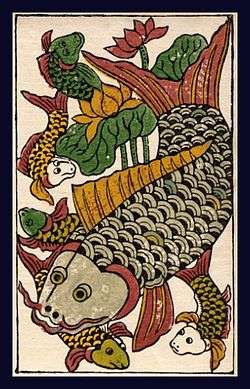
Bắc Ninh Province lies on the major traffic artery linking Vietnam and China – which is a strongly growing market and expected to be larger as the China - ASEAN free trade area is formed. It also lies on the Nanning - Lạng Sơn - Hanoi - Hai Phong and Nanning - Singapore economic corridors, the Hanoi capital city planning area and the busy Hanoi - Hai Phong - Quảng Ninh economic development triangle.
Bacninh Province is known as a light point in industrial development, has been lifting rapidly with long steps of industrialisation – modernisation. Bắc Ninh has 15 industrial parks with total areas of 7,681 ha, of which nine have operated effectively. The industrial parks have lured 272 foreign direct investment (FDI) projects totaling to over $3.7 billion, including those invested by Canon, Samsung, P&Tel, Sumitomo, Foxconn, ABB, Orion, PepsiCo and Nokia. They have attracted 254 domestic projects with total registered capital of over $1 billion and a labour force of more than 83,000. Bắc Ninh has as many as 120 handicraft-producing villages, 62 of which are involved in producing traditional products such as copper casting (Dai Bai-Gia Binh), iron and steel (Da Hoi-Tu Son), and wooden products (Dong Ky-Kim Son). They have the upper hand and high potentials to contribute much to Bắc Ninh's economic development.
In 2015, Gross Regional Domestic Product (GRDP) increased 8.7% compared with 2014. The economic structure shifted in the right direction with agro-forestry-fishery accounted for 5.3%, industry and construction accounted for 75.6% and service 19.1%. Industrial production value was estimated at VND 610 trillion, up 9.1%. The total retail sale of goods and consumer service revenue reached over VND 39.7 trillion, up 15.4%, the total export turnover of goods was estimated at USD 23.2 billion, up 6.4%, the total state budget revenue in the province was estimated at VND 14,500 billion, up 14.3%.[7]
Culture
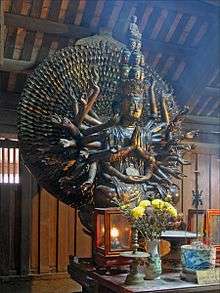
Bắc Ninh is hometown of not only Kinh Dương Vương – the very first king of ancient Viet ethic, but also of eight Kings of the Lý Dynasty. Many historical and cultural relics such as Đô Temple (where 8 kings of the Lý Dynasty are worshipped), Dâu Pagoda, the first pagoda in Vietnamese history, Bút Tháp Pagoda (an ancient pagoda), Phật Tích Pagoda, Dâu Pagoda and local Literature Temple. Bắc Ninh hosts thousands of local festivals from small to large, having special meaning such as the Dâu Pagoda festival, the Lim festival, the Đô Temple festival and the Bà Chúa Kho temple festival.
The quan họ style has its origins in what now constitutes the Bắc Ninh Province and was first recorded in the 13th century. It has traditionally been associated with the spring festivals that follow the celebration of Tết (the Vietnamese New Year). Quan họ is recognised as the Intangible Cultural Heritage by the UNESCO in 2009.
The village of Đông Hồ in the province of Bắc Ninh is known as a center of production of traditional Vietnamese woodblock prints (Đông Hồ painting), which are sold all throughout Vietnam in time for the Lunar New Year (Tết) celebrations.[8][9]
Hồ chicken (gà Hồ) is a breed originating in Bắc Ninh Province. Gà Hồ is a distinctly Vietnamese rare breed of chicken, familiar as a symbol in Vietnam. According to folklore, the chicken (particularly the roosters) have the five qualities of a man of honour: literacy, martial arts, physical strength, humanity and loyalty. The Gà Hồ rooster rising himself to welcome the sun is used as a symbol for the 3rd Asian Indoor Games, which were held in Vietnam from 30 October till 8 November 2009. The symbolism in the context of the AIGs is that the rising rooster linked to the readiness of the sports industry of Vietnam to host this major event.
List of festivals in Bắc Ninh Province:
| Name of festival and Conducted time | Location | Content |
|---|---|---|
| Phật Tích Pagoda festival (4th of the first Lunar month) | Phat Tich commune, Tiên Du District | Worship: "Quan Am" Buddha, and Emperor Ly Thanh Ton
Coming to Buddhist area, praying for happy and prosperity. |
| Dong Ky fire-cracker festival (the 2nd of the first Lunar month) | Dong Quang ward, Từ Sơn | Worship: Thien Cuong De (Hung Vuong regime)
Coming here to pray for lucky and happy and also have wrestle competition. |
| Chap festival (4th of the first Lunar month) | Hoa Long commune, Bắc Ninh | Worship: Truong Hong, Truong Hat
Competition: singing Quan Ho, and tug of war |
| Nga Hoang Festival (7th of the first Lunar month) | Yen Gia commune, Quế Võ District | Worship: Linh Son, Mi Nuong
Offering custom The Elbow custom of boys and girls |
| Tam Son Pagoda festival (8th–12th of the first Lunar month) | Tam Son commune, Từ Sơn District | Worship: Buddha
Entertainment: Puppet-showing, cockfighting, earthenware pot shattering, quan họ singing |
| Bo Son festival (9th of the first Lunar month) | Khac Niem ward, Bắc Ninh | The festival of Quan Họ village |
| Lim festival (13th–15th of the first Lunar month) | Van Tuong commune, Tiên Du District | Entertainment: Singing folk songs, Tug of war, Human chess, Cockfighting ... |
| Bà Chúa Kho temple festival (14th of the first Lunar month) | Co Me village, Vu Ninh ward, Bắc Ninh | Worship: Bà Chúa Kho
praying for happy and prosperity. |
| Diem festival | Viem Xa village, Hoa Long commune, Bắc Ninh | Worship: Thanh Tam Giang, Nam Hai Dai Vuong
Competition: Singing quan họ, to vie the ball with each other. |
| To Pagoda festival (18th–23rd of the first Lunar month) | Thai Bao commune, Gia Bình District | Competition:
Reading prayer-book, wrestling, regatta, weaving. |
| Phu Luu festival (8th of the third Lunar month) | Tan Hong ward, Từ Sơn | Worship: Tam Giang God
Competition: Singing folksong, chess, and wrestling ... |
| Dinh Bang village temple festival (12th–16th of the third Lunar moth) | Dinh Bang ward, Từ Sơn | Worship: God of mountain, God of river, and God of plants. Custom of sacrifice to the God Competition: wrestling, cockfighting |
| Đô Temple festival (14th-17th of the third Lunar month) | Dinh Bang ward, Từ Sơn | Worship: 8 Emperors of Lý Dynasty.
Custom: Coronation, Offering incenses. Entertainment: Releasing pigeon, wrestling, cockfighting, singing folksongs |
| Kham festival (7th of the fourth Lunar month) | Gia Dong commune, Thuận Thành District | Worship: 3 totelary Gods.
Custom: Receive with consideration Lac Long Quan to village temple praying for a good crop. Entertainment: Wrestling, cockfighting, chess |
| Dâu Pagoda festival (8th of the fourth Lunar month) | Thanh Khuong commune, Thuận Thành District | Worship: Phap Van statue
Custom: Pick up to pagoda, Offering incense, spaying Entertainment: stick dancing, dragon dancing ... Entertainment: Wrestling, cockfighting, chess |
Education
Primary and secondary education
Bacninh's education system is divided into 5 categories: pre-primary, primary, intermediate, secondary, and higher education.
Kindergarten and kindergarten for children from 2 to 5 years old to form thinking for children. Create the habit, the day of this period (not all children must learn this level).
Primary school level is also called the level, starting 6 years old. Level I consists of 5 levels, from grade 1 to grade 5. This is a grade school on, required for all students.
Secondary level education: Level II includes 4 levels, from grade 6 to grade 9. Students must learn to school subjects: Mathematics, Physics, Chemistry (grade 8.9), Biology, Technology, written language, History, Geography, Education Citizens, Foreign Language, Health, Parenting Music - Visual Arts.
In addition students have some information required such as: education outside the classroom on time, direction of education (grade 9), use of school ... To study the higher level students to participate in the examination enrollment.
Level secondary school: Level III consists of 3 levels, from grade 10 to grade 12. To graduate level III, students must participate in the graduation exam secondary school of education and training.Notable high schools in Bắc Ninh include Bắc Ninh High School for the Gifted, Thuan Thanh No 1 High School, among others. Though the former schools are all public, private education is also available in Bắc Ninh.
Students want to study in schools-public school to attend an examination of birth. The exam is held every year, by the Department of Education and Training of the local lead. At this level, students also study subjects similar in grade middle school. However, students in secondary school also take a number of other activities as the business, vocational ...
Higher education
Bacninh has had universities and colleges, vocational training skill secondary schools and centres providing investors with labour source suitable for demand on high technical qualification of enterprises.
- Bắc Ninh University of Physical Education and Sports(UPES1)
- Kinh Băc University
- Bac Ha International University
- People's Police University of Technology and Logistics - T36(Đại học Kỹ thuật - Hậu cần Công an nhân dân)
- Academy of Policy and Development
- Dong A University of Technology
Notable people
- Cao Lỗ
- Lý Thái Tổ
- Lý Thái Tông
- Lý Thánh Tông
- Lý Nhân Tông
- Lý Thần Tông
- Lý Anh Tông
- Lý Cao Tông
- Lý Huệ Tông
- Lý Chiêu Hoàng
- Ỷ Lan
- Nguyễn Văn Cừ
- Lê Quang Đạo
- Nguyễn Thuyên
- Lê Văn Thịnh
- Vạn Hạnh
- Andrew Dũng-Lạc
- Hoàng Anh Tuấn
- Hoàng Cầm
- General Phạm Văn Trà
- Lý Đạo Thành
- Lý Long Tường
- Nguyễn Gia Thiều
- Nguyễn Quảng Tuân
- Ngo Gia Tu
- Thích Huyền Quang
International relations
- Angola
The leader also expressed his wish to share the province's experience with Angola in investment promotion, contributing to fostering the friendship between the two peoples.They signed a memorandum of understanding on cooperation in forestry exploitation and processing, and the supply of construction workers in oil and gas to the African country.[10]
- Cambodia
Cambodia wants to tighten cooperation in many fields with Vietnam, including the northern province of Bắc Ninh, to deepen solidarity and friendship between the two countries.Cambodia will continue receiving Vietnam and Bắc Ninh Province's assistance in corruption prevention, meeting citizens and settlement of complaints and denouncements.
- Korea
Korea investment projects in northern Bắc Ninh Province have greatly contributed to the development of the province's key industrial sectors.
- Laos
Bac ninh committed to helping Hua Phan upgrade its infrastructure for agricultural production, mining and processing industries.Bắc Ninh will also help Hua Phan build a primary school and grant scholarships to students from Hua Phan studying in Vietnam.
- Japan
The Vietnam – Japan Friendship Organization held a prayer for peace at Bắc Ninh provincial Museum.A delegation from the ASEAN-Japan Centre visited Bắc Ninh on 24 October 2012 to learn about the investment environment in this northern province.
References
- ↑ http://www.vietnamonline.com/culture/quan-ho-folk-singing-a-long-way-from-the-past.html Quan họ folk singing
- 1 2 Statistical Handbook of Vietnam 2014 Archived 2015-07-06 at the Wayback Machine., General Statistics Office Of Vietnam
- ↑ UNESCO Culture Sector - Intangible Heritage - 2003 Convention :
- ↑ http://www.greentrailtours.com.vn/index.php?option=com_content&view=article&id=710:bac-ninh-climate&catid=34:need-to-know&Itemid=29
- ↑ "Bac ninh weather". Retrieved 27 June 2013.
- ↑ "Archived copy". Archived from the original on 2013-10-03. Retrieved 2013-07-08. , Vietnam General Statistics Office.
- ↑ "Deputy Prime Minister Vu Van Ninh works in Bac Ninh". Archived from the original on 6 January 2016. Retrieved 28 December 2015.
- ↑ Woodblock Printing
- ↑ Lisa Spivey, "Traditional Tet Paintings - Dong Ho Prints"
- ↑ "Angola learns about Bac Ninh's FDI attraction". Vietnam+. 25 March 2013. Retrieved 7 June 2018.
External links
| Wikimedia Commons has media related to Bac Ninh Province. |
| Wikivoyage has a travel guide for Bắc Ninh Province. |
